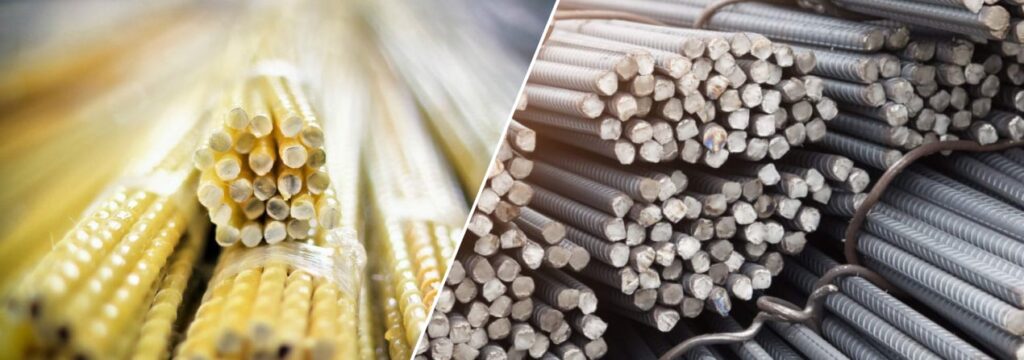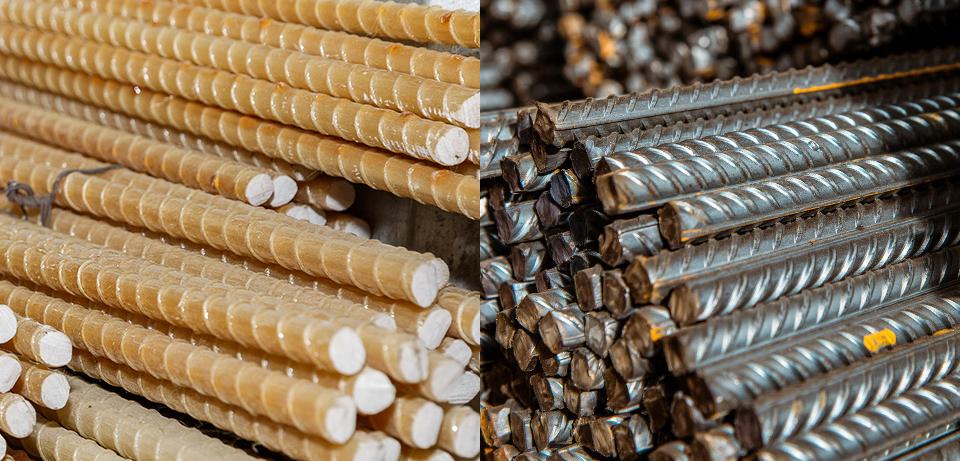En la industria de la construcción, en constante evolución, las varillas de refuerzo de polímero reforzado con fibra de vidrio (PRFV) se perfilan como una alternativa revolucionaria al refuerzo de acero tradicional. Si bien el acero ha sido la base del hormigón armado durante más de un siglo, las limitaciones derivadas de la corrosión, el peso y los costos de mantenimiento a largo plazo han llevado a ingenieros y contratistas a explorar alternativas no metálicas.
Las barras de refuerzo de PRFV, producidas a partir de fibras de vidrio de alta resistencia incrustadas en una matriz polimérica, ofrecen una combinación única de estructura liviana, resistencia a la corrosión y confiabilidad mecánica, lo que las hace ideales para una amplia gama de aplicaciones, desde proyectos de infraestructura hasta entornos marinos, puentes y plantas químicas.
En este artículo, ofrecemos una comparación exhaustiva del PRFV frente al refuerzo de acero, basada en datos reales, pruebas de laboratorio y análisis del mercado. También exploramos las ventajas económicas, los beneficios de instalación y los factores de sostenibilidad que hacen del PRFV la solución de vanguardia para el refuerzo de hormigón.
Contenido
¿Qué son las barras de refuerzo de PRFV?
La varilla corrugada de polímero reforzado con fibra de vidrio (PRFV) es un material compuesto fabricado con haces de fibras de vidrio de alta resistencia impregnadas con resinas de éster de vinilo o epoxi. El resultado es una alternativa a la varilla corrugada no corrosiva, ligera y duradera que no se oxida ni se degrada con el tiempo, incluso en entornos alcalinos o con alto contenido de cloruro.
Propiedades clave de GPRFV:
- ¼ del peso del acero
- 2 veces más resistencia a la tracción en comparación con el acero dulce
- No magnético y eléctricamente no conductor.
- Completely resistente a la corrosión
Acero vs. PRFV: Una comparación técnica
| Propiedad | varillas de acero corrugado | varillas de refuerzo de PRFV |
| Resistencia a la tracción | ~450 MPa | 800–1200 MPa |
| Módulo de elasticidad | ~200 GPa | 40–60 GPa |
| Peso | 1x | ~0,25x (75% más ligero) |
| Resistencia a la corrosión | Propenso a oxidarse | 100% resistente a la corrosión |
| Conductividad térmica | Alto | Muy bajo |
| Conductividad magnética | Magnético | No magnético |
| Resistencia a la fatiga | Medio | Alto |
Si bien el acero ofrece alta rigidez y familiaridad, presenta desventajas significativas en entornos agresivos. El PRFV, aunque ligeramente más flexible, se mantiene estable en agua salada, productos químicos y ambientes húmedos, lo que lo convierte en una excelente inversión a largo plazo.
Más información: Comparación técnica entre varillas de refuerzo de PRFV y varillas de refuerzo de acero

Análisis de costos: ¿Es el PRFV más barato que el acero?
A primera vista, las varillas de refuerzo de PRFV pueden parecer más caras por metro que las de acero. Sin embargo, la verdadera ventaja en términos de costo surge al considerar los costos del ciclo de vida.
Costo inicial
- Acero (Ø10 mm): ~$0,80–1,10 por metro
- PRFV (Ø10 mm): ~$1,30–1,60 por metro
Ventaja basada en el peso
- Una barra de PRFV pesa 75% menos → menores costos de transporte y manipulación
- Un trabajador puede transportar hasta 10 veces más PRFV que acero
Costo de instalación
- Corte más rápido (amoladora angular o hoja de diamante)
- No necesita soldadura ni conexión a tierra
- Manejo más seguro y sencillo
Ahorros a largo plazo
- El acero requiere recubrimientos, mantenimiento y, a menudo, reemplazo temprano.
- El PRFV dura más de 100 años sin degradarse
- Reducción del costo del ciclo de vida de hasta 70% en entornos corrosivos (fuente: Comité 440 de ACI)
Longevidad y resistencia a la corrosión
La corrosión es la principal causa de fallas del hormigón armado a nivel mundial. El acero comienza a oxidarse al exponerse a cloruros, carbonatación o humedad, lo que provoca grietas, delaminación y fallas estructurales del hormigón.
Ventajas del PRFV:
- Inmune a la corrosión, incluso en:
- Entornos marinos
- Exposición a la sal de deshielo
- Tanques químicos y plantas de tratamiento de aguas residuales
- No necesita recubrimientos ni selladores
- Reduce el espesor de la cubierta de hormigón (menos hormigón = estructura más ligera)
Resultado: El PRFV puede prolongar la vida útil de una estructura de 40 a 50 años a más de 100 años.
Estudios de caso: PRFV en puentes y construcción marítima
Estados Unidos: más de 2000 puentes
Según el Instituto Americano del Hormigón (ACI), más de 2000 puentes en EE. UU. se han construido con refuerzo de PRFV. Entre ellos se incluyen:
- Puente del río Halls, Florida
- Intercambio de la I-5, California
- Puente de Gills Creek, Carolina del Sur
Canadá: Barreras y estructuras de estacionamiento
El puente Champlain en Montreal incorporó PRFV en sus muros de barrera debido a su resistencia a las sales de la carretera.
Arabia Saudita: Plantas de desalinización
El PRFV es ahora estándar en entornos corrosivos donde el acero falla en cuestión de años.
Estos ejemplos muestran cómo los organismos gubernamentales y los contratistas privados están cambiando al PRFV por su confiabilidad y rentabilidad.
Sostenibilidad y Huella de Carbono
La construcción contribuye con hasta 39% de las emisiones globales de carbono, y la producción de acero es un contribuyente importante.
Beneficios ambientales del PRFV:
- La producción de PRFV emite 75% menos de CO₂ que la producción de varillas de acero
- Las estructuras que utilizan PRFV necesitan menos cobertura de hormigón, lo que reduce el uso general de hormigón.
- Ciclos de vida más largos = menos demolición y reconstrucción
Más información: Desempeño ambiental del FRP
Además, Equipos de producción de Composite-Tech permite a los fabricantes producir localmente PRFV, reduciendo las emisiones del transporte y apoyando los principios de construcción circular.
¿Es hora de reemplazar el acero?
En ambientes corrosivos, marinos y de alta humedad, varillas de refuerzo de PRFV Supera al acero en todas las categorías clave: durabilidad, peso, resistencia a la corrosión y costo del ciclo de vida.
A pesar de un precio inicial ligeramente más alto, el retorno de la inversión es significativo, lo que convierte al PRFV en la mejor opción para proyectos de infraestructura que exigen longevidad y mantenimiento reducido.
Es hora de dejar atrás los materiales obsoletos y adoptar una construcción moderna y sustentable con PRFV.
Comience a construir de forma más inteligente con Composite-Tech
En Composite-TechNo solo proporcionamos equipos de producción de PRFV: ofrecemos soluciones completas para el futuro del refuerzo.
- Comience su propia fabricación de varillas de refuerzo de PRFV o línea de producción de malla
- Obtenga capacitación y tecnología respaldado por certificaciones de construcción reales
- Mejore la eficiencia y sostenibilidad de su proyecto
Ya sea fabricante, contratista o desarrollador, podemos ayudarlo a:
Contáctanos hoy para explorar cómo podemos ayudar a su empresa a construir un mundo más inteligente, seguro y fuerte.
FAQ (Preguntas frecuentes)
¿El PRFV está aprobado por los códigos de construcción?
Sí. El GFRP está aprobado según ACI 440.1R, ASTM D7957 y varias normas internacionales.
¿Se puede utilizar PRFV en cimentaciones?
Absolutely. Es ideal para cimientos, losas y muros de contención, especialmente donde la humedad del suelo o los productos químicos presentan riesgos de corrosión.
¿Puedo doblar el PRFV en el sitio?
No, el PRFV no se puede doblar en frío como el acero. Sin embargo, Composite-Tech ofrece equipos de doblado para elementos de PRFV preformados.
¿Qué pasa con la resistencia al fuego?
El PRFV se degrada a temperaturas sostenidas superiores a 300 °C, pero esto se puede mitigar mediante el aumento del espesor de la cubierta y aditivos resistentes al fuego.
Preguntas frecuentes sobre equipos Composite-Tech y tecnología GFRP
Más información:
- ¿El mejor fabricante de líneas de producción de varillas de refuerzo compuestas de FRP?
- Por qué los clientes de todo el mundo eligen a Composite-Tech como el proveedor más confiable de equipos para la producción de varillas de refuerzo de PRFV
- Cómo Composite-Tech mejora la producción de varillas de refuerzo compuestas

